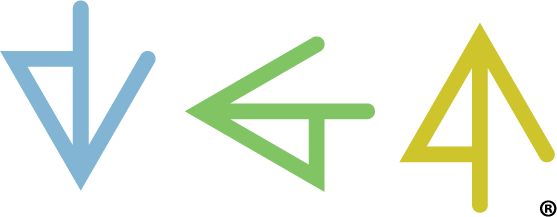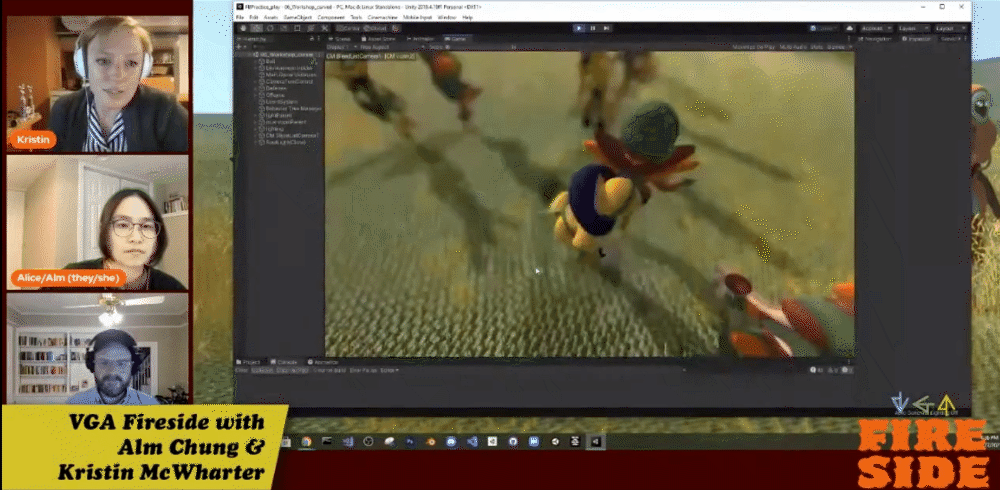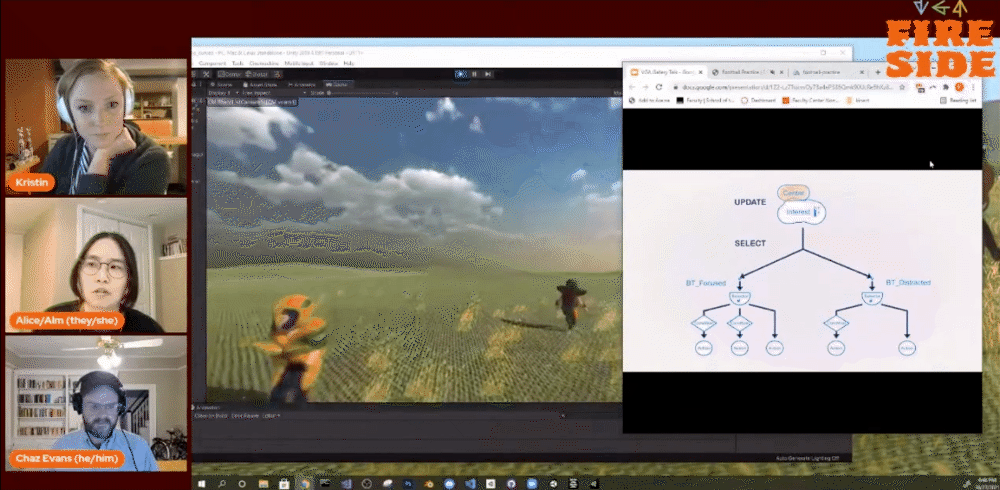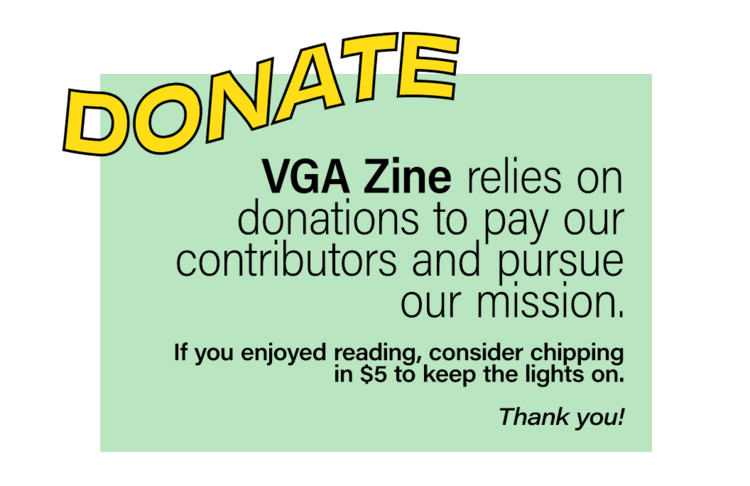VGA Fireside Ep. 9 feat. Alm Chung & Kristin McWharter: Interview Highlights
For the ninth episode of VGA Fireside, Director of Exhibitions, Chaz Evans sat down with Alice Chung and Kristin McWharter to discuss their ongoing project, Football Practice.
Chung is a researcher and publisher of zines and games, while McWharter is a multi-disciplinary artist whose work explores the entangled relationship between competition and intimacy. The two met in the design and media arts program at UCLA where they combined their interests to launch a unique take on the simulation of football based on its cultural impact today.
Below are some highlights taken from the conversation between the artists and Chaz Evans. The full interview can be found on VGA Gallery’s YouTube and Twitch channels, where you can also see a realtime simulation of the state of Football Practice as of October 27th, 2021.
How Alice got started with creating video games
Alm Chung: I was a typical anime fan, video game nerd kid. So growing up I made small games with RPG Tsukūru or RPGmaker in English, and through tons of fan art.
Back then, contemporary art felt very distant from me to be honest. My undergraduate degree was in bioengineering. I worked as a researcher. I did prototyping in a university lab and we built remote experimentation systems for microbiology. And to be honest, I don't think I knew what I was doing or wanted to do back then; just working.
And then I was able to take courses offered by the university. I was lucky. And there was a class called Internet Art. And this was my first time seeing works by all these contemporary art stars… because their works were actually really relatable for me as like an internet kid. But also very confusing, in a good way. And for the first time in my life in that class, I coded something, but not for a class assignment or not for a boss, but just for myself, to express myself. And that felt really great.
So after that encounter, I started making small works like, yeah, small works about like anything, just grabbed my attention. And then I eventually found the MFA program that welcomed me. And here, I met so many cool people making art and I was inspired. I was exposed to more game art and game development discussions there. So yeah, inspired by all these new inputs, then I was able to finally make game art. I made the old school RPG style sprites generator. Using one of the deep learning techniques, it was very hard back then to search about diverse networks or GANs, maybe you heard about GAN art, to be specific. And yeah, I think that was my first game art. And from there, I've been working on various small projects, or big ones, I guess; art or design projects.
How Kristin got started with creating video games
Kristin McWharter: In my undergrad I studied sculpture and performance. And so I feel like my background was pretty heavily rooted in this art school space. I was really inspired by Fluxus and performance art in sort of the 1960s happenings. And after undergrad, you know, I was just like this lost person in the world with an interdisciplinary sculpture degree trying to find employment, and had a lot of really funny, odd jobs.
I was a doll restorator for a while. I worked in a lot of coffee shops. Lots of odds and ends, and somehow magically, and I don't really know, to this day, how it happened. I still like held on to this passion and this need to be making things and to run a studio practice on the side. And in those sparks I was really interested in competition and the way that competition felt like this weird intimacy roleplay. And for me there's this sort of lens that sits on top of a lot of games, this question of like, Is this actually a roleplay for something else, especially when it's adults who are playing and not children?
And so I was starting to create these performances that were using a lot of sensors, like biometric sensors and microcontrollers. And I needed to suddenly learn how to code, and I got involved with some digital hardware foundation in Baltimore, different tech spaces. And suddenly, I was like, Oh, this is like a whole thing, like artists who use these kinds of tools, I should explore this. And so that brought me to the Design Media Arts program at UCLA, where I met Alice and Phase and a bunch of other really amazing, talented people. And while I was there, there's the Game Lab hosted inside of that program. And that exposed me to a lot of tools that I just hadn't been aware of before. In particular Unity and game engines, and this idea of real time interactive systems. And those tools ended up becoming part of my performance practice. And since the pandemic, my work has become less physically performance oriented, and has become more digitally performance oriented. To be honest, I don't know where it's gonna go completely, but that's where I'm at and how I got here.
On the origins of Football Practice and how the collaboration came to be
KW: It was early 2019 I want to say, and I'd been doing a lot of research into cheerleaders, and had been really interested in that particular role inside of professional sports. And it occurred to me at the time, there was a lot of media going on about this, these sort of exposés on cheerleader treatment inside of the NFL, and their wages, and how cheerleaders on average were making about minimum wage if you broke down their salary to an hourly rate, and had very little job security and were facing some of the like, most obscene body scrutiny and misogyny in the workplace.
And it made me question like, why on earth would anybody be a cheerleader? What is this role? What is it like representing? I'd also been at the time really interested in learning more about game maths, and specifically around the game Madden. And that Madden was this game I was really interested in because it had this huge fanfare, and also had like, produced all of these things like the flyover camera that then got adopted by the NFL. And so the way that we see and watch the actual game of football is hugely influenced by this virtual version of the game, to the point that they're sort of inextractable from each other.
I wanted to make a simulator of the game that asked the question, what if the cheerleaders were the players rather than the football players? And so I had applied for a grant through Chicago Artists Coalition, the Envision grant, and they gave it to me, which was amazing. Then I had to sort of make this thing, and I didn't know how to do any of it! So I called Alice because Alice had done all of these really amazing AI-generated zines and AI-generated small works throughout our time in grad school, and I was like, I have this idea. Do you think we could go somewhere with this?
CE: And then Alice enters the picture.
AC: So, on my side, after graduate school, I was again, floating around in California, and everywhere. And then one day, Kristen called me and I was listening to her new project idea, and the word simulation just piqued my interest. I was like, Oh, yeah! And then she showed me the Madden 21 promo video, and I'm like, no, I can't make that, right? Then she sent me a link to 17776 SBnation: What football will look like in the future, an interactive experience. And then I was very hooked. I think that that kind of worked as a great starting point for both of us, right?
On Biotic games and how Alice’s experience in bioengineering influenced Football Practice
AC: First, what, what are biotic games? So the lab that I worked at was interested in biophysical phenomena happening around single or multiple cells. And we built experimentation systems to study their phenomena. And at that specific time, the big question we had was, can we build an interface to interact with cells or microorganisms? Can you build a biophysics learning system to replay our exploration?
So there's like an interface design thing going. We were very lucky to work with really cool freshwater species called paramecium and euglena. And these single celled eukaryotes are extra fun, because 1) they can grow, and 2) they move around to specific stimuli, such as electric fields or light. So if you shine lights to the euglena, the cell will swim away or toward the light, depending on how bright the light sources are. So you can control them. With some proper setup, you can control the movement of these guys.
When we had the setup and we were playing around with it, it was very natural for us to just think, Oh, we can make a video game! And that actually happened. So I ended up making paramecium pong, paramecium soccer, paramecium Pac Man, paramecium Breakout, a euglena traffic game as well. So you get the idea: very simple, like some kinds of classical, early day video games, but just using the euglena. It's like a player character.
But remember this is actually situated in a science lab, and science engineering departments. So all these games were required to provide a model for building models and actually testing the model… And after playing, the players are expected to create a behavior model for euglena and try to fit the data they collected during the gameplay with their model. So with a built model, you're supposed to run multiple simulations, and compare the behavior of your model with how the actual euglena moved around or behaved. And this is like you're constantly playing and replaying the video game.
So you make so many models until you rule out all wrong guesses about the mechanism of the euglena behavior, and eventually you have to land on the best model with the smallest error margin. So if you step out a bit from this, whatever I just described, you now realize the actual hidden goal of the biotic game is actually to deplete all possible models, or possible outcomes until you kind of converge to the absolute answer.
CE: How similar is the paramecium to a football player?
AC: If you think about any typical simulation game, the goals kind of differ. Whenever there’s a simulation game, they kind of try to suggest there'll be so many possibilities; like, there'll be many different endings that you can get to. And that's what people want to hear. And the promise of this endless possibility may be more exciting. Like, that's the most exciting thing about having a simulation game.
On how they decided on the aesthetic and feel for the players in Football Practice
KM: Alice and I had a lot of conversations early on about how much control we wanted to have over the aesthetic of this game, and whether or not we wanted the sort of look and feel of the players to be designed designed by workshop participants. And we decided against that, because we felt like it would too easily slip into this sort of open world game. But we did want to let go of our own control over what we thought a football player should look like.
So in the workshops, there are questions that asked about the physicality and origin stories of these players. Some workshop participants choose to make them human, and some workshop participants choose to make them like inhuman. But Anna Strain, our amazing illustrator, is the one who sort of synthesizes all of that information and comes up with the starting point for the look of these. And a lot of the sci-fi aesthetic comes from their uniforms. And she's just really talented at actually making sort of decisions about what a speculative utilitarian football suits would look like, based on the attributes of those players. So those illustrations become the basis of that and how the 3D modelers interpret what they look like.
On how the workshops get incorporated into the simulation
KM: So from those workshops, from those conversations, the profile of these speculative players are generated, and that begins an origin point for Exquisite Corpse. Then that description gets passed on to our Illustrator, the very talented Anna Strain, who builds a concept illustration for this player. And that gets passed on to our 3D modelers, Sara Drake, Natalee Decker and Adrian Pijoan who interpret those illustrations into 3D models.
And then based on those 3D models, illustrations and character sheets, Alice and I build out a Unity world and a behavior tree algorithm for each one of these players, and they enter our speculative team. And then alongside these workshops, we are also running our simulation and our players play with each other and train and try to learn how to play football alongside the drafting process of each player.
On how they determined how the goal of the simulation
KM: So Alice and I went back and forth a lot when trying to figure out what our version of Madden would be. And there was actually, I feel I remember us fighting a lot early on in our collaboration, because they think my technical knowledge of what I was trying to achieve was just like, really out of scope. And but where we ended up going was thinking about if Madden is a simulation of football that's based on extracting motion capture data from players, so capturing some aspect of their physicality and their body, and then conjoining that with their players statistics, and that it is this extraction of a kind of data from the real game that then gets simulated out. Is there an alternative to that complexity that we were interested in?
What we really landed on is that we're not really interested in the statistics of the game and it's and how it's performed, we're more interested in the cultural impact of the game and how it's shaped by who's playing. And so we crafted these workshops in a way of reimagining who we associate football with and what kind of cultural connotations we associate football with. And so the workshops are based on this surrealist game called Exquisite Corpse, and each one, and we're designing players for this future speculative football game based on a similar process as Exquisite Corpse.





